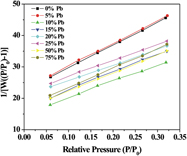Crossref Citations
This article has been cited by the following publications. This list is generated based on data provided by
Crossref.
Al-Hartomy, Omar A.
Ubaidullah, Mohd
Kumar, Dinesh
Madani, Jamal H.
and
Ahmad, Tokeer
2013.
Dielectric properties of Ba1-xSrxZrO3 (0 ≤ x ≤ 1) nanoceramics developed by citrate precursor route.
Journal of Materials Research,
Vol. 28,
Issue. 8,
p.
1070.
Ahmad, Tokeer
Khatoon, Sarvari
and
Phul, Ruby
2013.
A Review on Chemical Synthesis, Characterization and Optical Properties of Nanocrystalline Transition Metal Doped Dilute Magnetic Semiconductors.
Solid State Phenomena,
Vol. 201,
Issue. ,
p.
103.
Ahmad, Tokeer
Wani, Irshad A.
Ahmed, Jahangeer
and
Al-Hartomy, Omar A.
2014.
Effect of gold ion concentration on size and properties of gold nanoparticles in TritonX-100 based inverse microemulsions.
Applied Nanoscience,
Vol. 4,
Issue. 4,
p.
491.
Ahmad, Tokeer
Wani, Irshad A.
Al-Hartomy, Omar A.
Al-Shihri, Ayed S.
and
Kalam, Abul
2015.
Low temperature chemical synthesis and comparative studies of silver oxide nanoparticles.
Journal of Molecular Structure,
Vol. 1084,
Issue. ,
p.
9.
Ahmad, Tokeer
and
Phul, Ruby
2015.
Magnetic Iron Oxide Nanoparticles as Contrast Agents: Hydrothermal Synthesis, Characterization and Properties.
Solid State Phenomena,
Vol. 232,
Issue. ,
p.
111.
Ahmad, Tokeer
2017.
Hydrothermal Synthesis, Characterization and Dielectric Properties of Zirconia Nanoparticles.
Material Science & Engineering International Journal,
Vol. 1,
Issue. 3,
Ahmad, Tokeer
Ubaidullah, Mohd
Lone, Irfan H.
Kumar, Dinesh
and
Al-Hartomy, Omar A.
2017.
Microemulsion synthesis, structural characterization and dielectric properties of Ba 1-x Pb x ZrO 3 (0.05 ≤ x ≤ 0.20) nanoparticles.
Materials Research Bulletin,
Vol. 89,
Issue. ,
p.
185.
Ahmad, Tokeer
Lone, Irfan H.
Ansari, S.G.
Ahmed, Jahangeer
Ahamad, Tansir
and
Alshehri, Saad M.
2017.
Multifunctional properties and applications of yttrium ferrite nanoparticles prepared by citrate precursor route.
Materials & Design,
Vol. 126,
Issue. ,
p.
331.
Ahmad, Tokeer
Ubaidullah, Mohd
Shahazad, Mohd
Kumar, Dinesh
and
Al-Hartomy, Omar A.
2017.
Reverse micellar synthesis, structural characterization and dielectric properties of Sr-doped BaZrO3 nanoparticles.
Materials Chemistry and Physics,
Vol. 185,
Issue. ,
p.
31.
Ubaidullah, Mohd
Ahmed, Jahangeer
Al-Enizi, Abdullah M.
Tyagi, Akshi
Shaikh, Shoyebmohamed F.
Tarannum, Nazia
and
Ahmad, Tokeer
2020.
Metal organic precursor derived Ba1-xCaxZrO3 (0.05 ≤ x ≤ 0.20) nanoceramics for excellent capacitor applications.
Journal of King Saud University - Science,
Vol. 32,
Issue. 3,
p.
1937.
Lone, Irfan H.
Aslam, Jeenat
Radwan, Nagi R.E.
Akhter, Arifa
Bashal, Ali H.
and
Shiekh, Rayees A.
2020.
Review on Polymeric Citrate Precursor and Sono-chemical Methods for the Synthesis of Nanomaterials.
Current Analytical Chemistry,
Vol. 16,
Issue. 7,
p.
826.
Khirade, Pankaj P.
Raut, A.V.
Alange, R.C.
Barde, W.S.
and
Chavan, Apparao R.
2021.
Structural, electrical and dielectric investigations of cerium doped barium zirconate (BaZrO3) nano-ceramics produced via green synthesis: Probable candidate for solid oxide fuel cells and microwave applications.
Physica B: Condensed Matter,
Vol. 613,
Issue. ,
p.
412948.
Wang, Siyu
Yan, Huimin
Zhao, Donghui
Tan, Zhicheng
and
Shi, Quan
2021.
Low temperature heat capacity and thermodynamic function of BaZrO3 and PbZrO3.
The Journal of Chemical Thermodynamics,
Vol. 158,
Issue. ,
p.
106449.
Ubaidullah, Mohd
Fazil, Mohd
and
Ahmad, Tokeer
2022.
Short review on fabrication, structural and dielectric characterization of zirconium based oxide nanoparticles.
Material Science & Engineering International Journal,
Vol. 6,
Issue. 4,
p.
152.
López-Esquivel, R.I.
Guzmán-Olguín, J.C.
Vázquez-Flores, N.
Correcher, V.
Benavente, J.F.
Guzmán-Mendoza, J.
and
Rivera Montalvo, T.
2023.
Green synthesis, structural and luminescent characterization of BaZrO3:Eu3+ nanoparticles.
Ceramics International,
Vol. 49,
Issue. 1,
p.
413.



